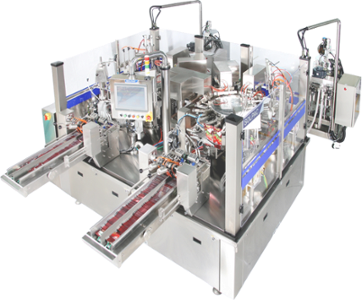

NOTICE:
Flexible packaging is any package or part of a package whose shape can be readily changed. It includes packaging made of paper, plastic, film, foil, metalized or coated papers and film, or a combination of these materials. These packages take the shape of pouches, stick packs, bags, sachets and wraps. Flexible packaging is used in every consumer product market.
The flexible packaging industry had $31 Billion of sales in the United States in 2015. It employs approximately 79,000 people in 950 manufacturing facilities in the United States.i Flexible Packaging has been leading the way in packaging innovation since the early 1950s, and is at the forefront of important packaging trends in product protection, packaging design and performance, consumer convenience, and sustainability. The attributes of flexible packages positively impact the environment, consumers and businesses. Flexible Packaging Delivers Measurable Sustainability When assessing sustainability, examining the full life cycle of a product/package is critical, and the overall life cycle assessment of flexible packaging is exemplary. Flexible packaging is the optimum environmental choice because:
1. Flexible packaging uses fewer natural resources, less energy in manufacturing and creates fewer greenhouse gas emissions.
2.To transport unfilled packaging for the same amount of product requires 26 truckloads of glass jars,
one truckload of flexible pouches. The savings on fuel and greenhouse gas emissions are dramatic.
3.1.5 pounds of flexible plastic will package the same amount of beverage or liquid foods as 50 pounds of glass.
4.Producing a flexible food service pouch requires 75% less energy than making a metal can for the equivalent amount of product, while generating only 1/10th of CO2 emissions in production.v A recent study by the Natural Resources Defense Council shows that up to 40% of food in the U.S. is wasted. Flexible packaging has demonstrated a capacity to reduce this waste.
5.The shelf life of cucumbers wrapped in flexible packaging was extended from three days to 14 days
6.Bananas packaged in flexible packaging slowed the ripening process and prolonged shelf life (15‐35 days).
Flexible Packaging Industry Overview
Flexible packaging has the ability to package the most product in the least packaging possible. Consequently lowering product warehousing and shipping costs while maintaining or improving product protection.
From 2002‐2010, advances in materials and production processes reduced the weight of flexible packaging,some by 40 percent.
Recycling and resource recovery options for flexible packaging include the generation of engineered energy feedstocks
About 50% of flexible packaging is multi‐material laminates and require
alternative methods for post‐diversion strategies. This equates to only approximately 1.6% of the municipal solid waste stream.
The flexible packaging industry is working in partnership with multiple stakeholders to expand waste recovery options as a solution to waste issues Flexible Packaging Materials Are Designed to Protect Products & Consumers Different products require different packaging attributes. Some are simple, some are complex, and each has a purpose The more complex the packaging requirement, the more complex the packaging structure – some requiring multiple layers of highly engineered materials to provide the optimal protection for the product, extending shelf life, reducing product waste, and creating lighter weight packaging.
Continual improvements in film barriers for refrigerated foods now keep meat fresh for up to 23 days longer. Intelligent sensor film can even warn the consumer when meat and fish are past their freshness date!
The use of flexible pouch materials reduces shipping costs, improve food quality, and reduce cooking time. Additionally, flexible packaging materials sold in the U.S. must also comply with extensive federal safety regulations under a framework of laws and regulations, depending upon the packages end‐use, including: The Food, Drug & Cosmetics Act (FD&C) The Consumer Product Safety Improvement Act (CPSIA) & The Consumer
The Consumer Product Safety Improvement Act (CPSIA) & The Consumer Product Safety Act (CPSA)The U.S flexible packaging industry is vibrant and growing because it creates unique solutions for many packaging challenges. When considering the full life cycle of flexible packaging it has superior sustainability attributes including using less material, less energy and creating less GHG emissions and waste.

©Shandong China Coal New Energy Import Export Co., Ltd. © 2017
Address:No. 11, North of Kaiyuan Road, High-tech Zone, Jining City, Shandong Province, China